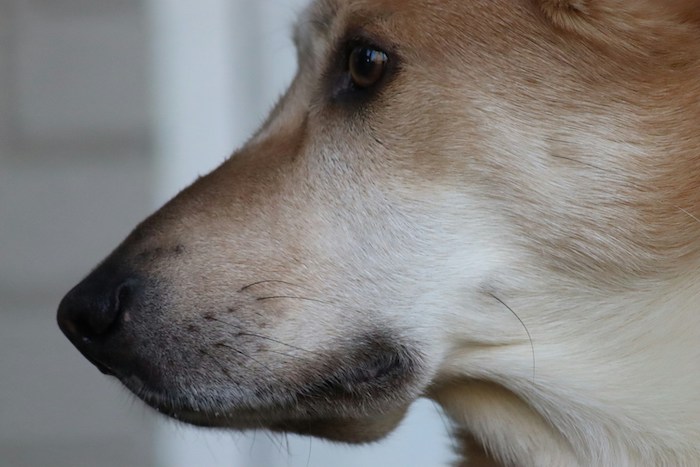
There is no shortage of hot-button topics in the dog world (one need only read a forum on dog food, for example, to get a sense of how contentious debates can get: Raw diet/ commercial food; grain free/not grain free; kibble/homemade…)
We have another one to add to the list: Whiskers.
A bit of background on the subject: Whiskers are special hairs that are stiffer and more embedded in the skin than other hairs found on a dog. Also called vibrissae, they act as sensors (or feelers) because at the base of each whisker is a high concentration of touch-sensitive specialized cells. These cells are so, well, “touchy,” that they can pick up on a gentle change in air currents. Whiskers can serve as early warnings to a dog (“hey, you’re about to walk into a wall!) because as a dog moves, he or she displaces air. The air bounces off of surfaces and back at the whiskers bending them just enough to alert the dog. Whiskers help puppies find mom (and milk!), and can help with spatial awareness.
Debate about dog whiskers can revolve around their functionality, or how essential are they really for a dog’s well-being? Some argue that dog whiskers are specially adapted to help dogs navigate the world around them, others claim that cutting them off doesn’t hurt the dog since the hairs don’t contain pain receptors. Some point out that the importance of whiskers for a domesticated dog hasn’t been scientifically proven, and so debate continues.
- Norwegian Buhund – Any shaving or trimming of the coat or shaving of whiskers, is to be severely penalized
- Icelandic Sheepdog: Specimens where the coat or whiskers have been altered by trimming or clipping shall be so severely faulted as to be effectively eliminated from competition
- American Eskimo Dog: There is to be no trimming of the whiskers or body coat and such trimming will be severely penalized
- Chinook – Trimming of the coat, including whiskers, is to be severely penalized
Other standards are less inflexible sounding, but instructive nevertheless by indicating: “Leave ’em alone:”
- Entlebucher Mountain Dog – Whiskers to be left natural
- Border Collie: Whiskers are untrimmed
- Mudi – Whiskers shall be present
- Finnish Spitz – Whiskers shall not be trimmed
- Tibetan Spaniel – Whiskers are not to be removed
- Shiba Inu – It is preferred that whiskers remain intact
- Irish Red and White Setter- No other trimming is allowed including the whiskers which shall remain intact
- Nova Scotia Duck Tolling Retriever – Whiskers must be present
- Rat Terrier -Whiskers must not be removed
- American Hairless Terrier- Whiskers are not removed
- Leonbergers are to be presented with no sculpting, scissoring, trimming of whiskers
- Samoyed -Whiskers are not to be removed.
Some standards leave it to owner preference:
- Pembroke Welsh Corgi – if desired, remove the whiskers
- Norwegian Elkhound -Trimming of whiskers is optional (making this the only hound to mention whiskers)
- Cardigan Welsh Corgi – if desired, remove whiskers
- Schipperke-only trimming of the whiskers and the hair between the pads of the feet is optional
- Keeshond – trimming permissible only on feet, pasterns, hocks and – if desired – whiskers
- Chow Chow – Trimming of the whiskers, feet and metatarsals optional
- Clumber Spaniel – Trimming of whiskers is optional
- Newfoundland – Whiskers need not be trimmed
- Siberian Husky – Trimming of whiskers and fur between the toes and around the feet to present a neater appearance is permissible
- Great Dane – Whiskers may be trimmed or left natural.
In some standards, it’s implied that whisker treatment is at the owner’s discretion but that untrimmed is preferred:
- Miniature American Shepherd – Untrimmed whiskers are preferred
- Vizsla – Whiskers serve a functional purpose; their removal is permitted but not preferred
- Flat-Coated Retriever – Whiskers serve a specific function and it is preferred that they not be trimmed
- Golden Retriever – Removal of whiskers is permitted but not preferred.
And finally, one standard, a toy breed, makes no mention about trimming, but tacitly implies that the presence of whiskers is important to type:
- Pekingese – Whiskers add to the desired expression
Photo by Gabriela Natiello on Unsplash

While shaving whiskers on dogs has always been controversial, shaving whiskers on cats has always been considered a grand mistake. No groomer that I ever knew shaved whiskers on cats. It was thought that cats relied on their whiskers more than dogs. I always wondered why that is.